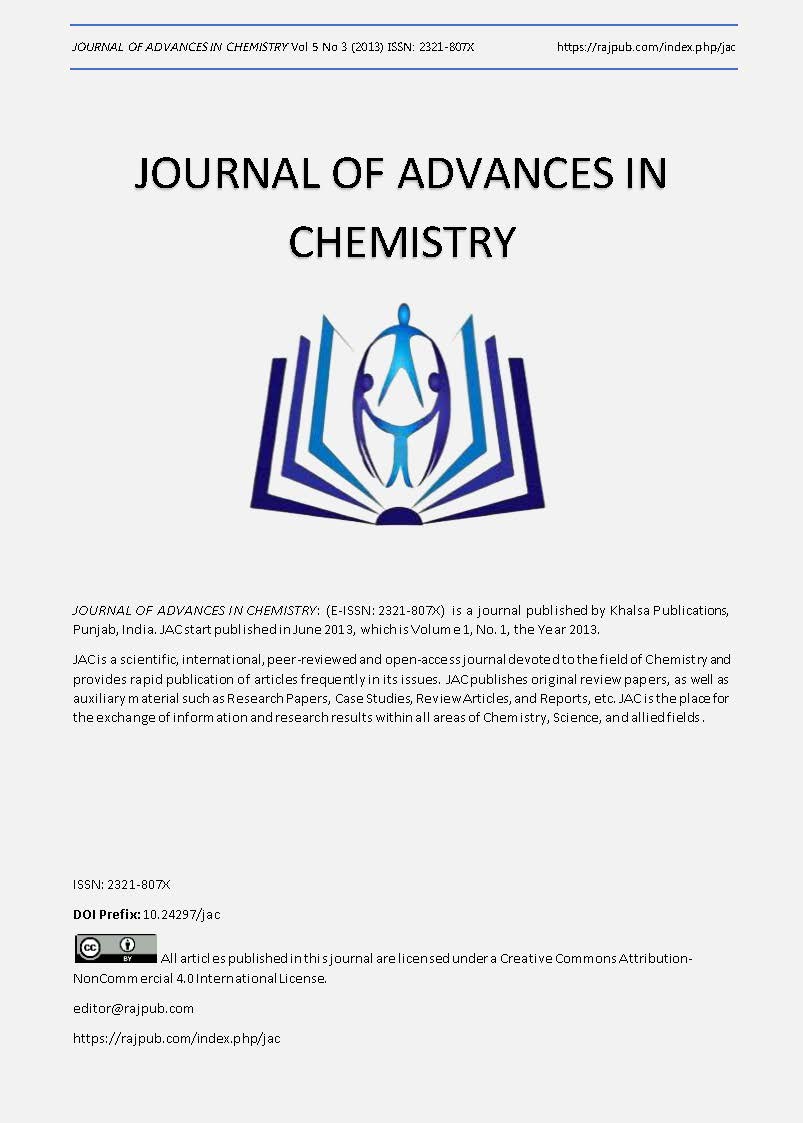Defluoridation of South Tunisian Brackish Water by Alum Coagulation/Flocculation: A Preliminary Work
DOI:
https://doi.org/10.24297/jac.v5i3.6592Keywords:
Defluoridation, brackish Tunisian water, coagulation-flocculation, Alum, full factorial designAbstract
Fluoride removal from aqueous solution was investigated using the chemical coagulation-flocculation by alum in reason of the efficiency and the simplicity of the process. Preliminary experiments were carried out to study the effect of some operating parameters such as: pH, initial fluoride concentration, coagulant dose, adjuvant coagulation dose, flocculent dose and settling time. Obtained experimental results showed that the treatment of fluoride by alum coagulation causes acidification of the solution. The effect of the initial pH solution on fluoride removal is negligible. Experimental results proved that coagulation process is effective in waters with low or medium levels of fluoride. Defluoridation rate was seen to increase with increasing coagulant and adjuvant coagulation doses. Optimal flocculent dose and optimal settling time were found 4.2 mg L-1 of FABI and 60 min respectively. Subsequently, experimental design methodology using two-level full factorial design was applied to optimize the defluoridation by coagulation-flocculation. Therefore, four operating parameters which are supposed to affect the removal efficiency were chosen: initial fluoride concentration, coagulant dose, coagulation adjuvant dose and settling time. From the statistical analysis, it is inferred that the four studied parameters have an influence on the fluoride removal. In fact, initial fluoride concentration has a positive effect unlike coagulant dose, coagulation adjuvant dose and settling time. Experiment tests were performed to evaluate the efficiency of coagulation-flocculation process for south Tunisian brackish water with high fluoride concentration. The obtained results showed that fluoride removal reached 59%.
Downloads
References
[2] Pontié, M., Schrotter, J., Lhassani, C. A., Diawara, C. K., 2006. Traitement des eaux destinées à la consommation humaine, Elimination domestique et industrielle du fluor en excès, Fluor et Environnement, L’actualité chimique - N° 301-302, 2-7.
ISSN 2321-807X
740 | P a g e D e c e m b e r 0 5 , 2 0 1 3
[3] W., Gonga, Qua, J., Liua, R., Lana, H., 2012. Effect of aluminum fluoride complexation on fluoride removal by coagulation, Colloids and Surfaces A: Physicochem. Eng. Aspects 395, 88-93.
[4] Mouna, B., 2005. Cartes de fluor et de fluorose en Tunisie, Thèse en médicine dentaire, Monastir, Tunisie.
[5] AFSSA, 2004. Évaluation des risques sanitaires liés aux situations de dépassement des limites et références de qualité des eaux destinées à la consommation humaine, Paris, 96.
[6] J. Zhu, H. Zhao, J. Ni, 2007, Fluoride distribution in electrocoagulation defluoridation process, Sep. Purif. Technol. 56, 184-191.
[7] Mjengera, H., Mkongo, G., 2004. Appropriate deflouridation technology for use in flourotic areas in Tanzania, Phys. Chem. Earth 26, 1097.
[8] Shen, F., Chen, X., Gao, P., Chen, G., 2003. Electrochemical removal of fluoride ions from industrial wastewater, Chem Eng. Sci. 58, 987.
[9] Rossini, M., Garcia Garrido, J., Galluzzo, M., 1999. Optimization of the coagulation-flocculation treatment: influence of rapid mix parameters, Water Research 33 N°8, 1817-1826.
[10] Hu, C., Liu, H., Chen, G., Qu, J., 2012. Effect of aluminum speciation on arsenic removal during coagulation process, Sep. Purif. Technol. 86, 35-40.
[11] Duan, J., Gregory, J., 2003. Coagulation by hydrolysing metal salts, Adv. Colloid Interface Sci. 100-102, 475-502.
[12] Verma, A. K., Dash, R. R., Bhunia, P., 2012. A review on chemical coagulation/flocculation technologies for removal of colour from textile wastewaters, J. Environ Manage. 93, 154-168.
[13] Masschelein, W. J., 1999. Processus unitaires du traitement de l’eau potable, Ed CEBEDOC.
[14] Behbahani,M., Alavi Moghaddam, M. R., Arami, M., 2011. Techno-economical evaluation of fluoride removal by electrocoagulation process: Optimization through response surface methodology, Desalination 271, 209-218.
[15] Youcef, L., Achour,S., 2001. Defluoruration des eaux souterraines du sud algérien par la chaux et le sulfate d'aluminium, Courrier du Savoir Scientifique et Technique N°01 : 65-71.
[16] Nieboer, E., Gibson, B.L., Oxman, A.D., Kramer, J. R., 1995. Health effects of aluminum : a critical review with emphasis on aluminum in drinking water Environ. Reviews 3, 29-81.
[17] Zhang, G., Gao,Y., Zhang,Y., Gu, P. 2005. Removal of fluoride from drinking water by a membrane coagulation reactor (MCR), Desalination 177, 143-155.
[18] Goupy, J. 1996. "Techniques de l’ingénieur, La méthode des plans d’expériences", DUNOD, Paris.
[19] Haaland, D. P. 1989. "Experimental Design in Biotechnology" Marcel Dekker Inc. New York.
Downloads
Published
How to Cite
Issue
Section
License
 All articles published in Journal of Advances in Linguistics are licensed under a Creative Commons Attribution 4.0 International License.
All articles published in Journal of Advances in Linguistics are licensed under a Creative Commons Attribution 4.0 International License.




